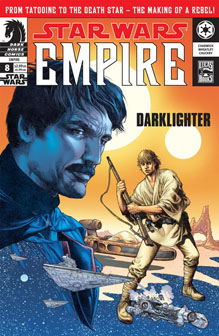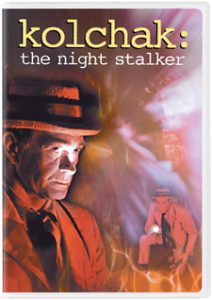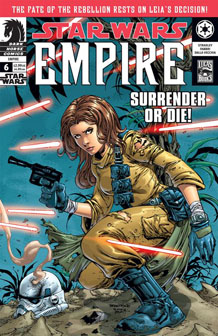“Star Wars” comic storytellers have repeatedly been drawn back to the time period of the first movie, 1977’s “Episode IV: A New Hope.” Marvel tackled it first, in Issues 1-38 of its original run. After “The Empire Strikes Back” came out, Archie Goodwin and Al Williamson chronicled the era in the newspaper strips (later collected in the “Classic Star Wars” comics). After “Return of the Jedi’s” release, Blackthorne Comics explored the “ANH” era in the three-issue “Star Wars 3-D,” and the “Droids” TV series chronicled the time slightly before “Episode IV.”
In 2012, with all six movies to draw from, Dark Horse revisited the classic era with the simply titled “Star Wars.” And on the TV front, “Rebels” will launch tonight on Disney Channel (although oddly, no comics are planned). But the best portrayal of the “ANH” era remains Dark Horse’s “Empire.”Launched in September 2002, it was the first ongoing series in the classic era to take advantage of the storytellers’ new prequel knowledge.
In writer Scott Allie’s “Betrayal” (Issues 1-4), set “in the weeks just prior to ‘A New Hope,’ ” Darth Vader flashes back to “cut scenes” of sorts from “The Phantom Menace” and “Attack of the Clones.” On the Coruscant landing platform, Anakin questions whether he’s fit to be a Jedi, and Qui-Gon assures him he is. At the Lars farmstead, Anakin tells Padme he feels like he failed his mother.
No doubt inspired by “Episode II’s” clone troopers, Allie dreams up “drone troopers” – stormtroopers that are entirely obedient, like machines. One Imperial conspirator uses the clone soldiers to bump off a fellow conspirator. While confusing at times, “Betrayal” wraps with an artful final issue where Darth Vader and the Emperor simultaneously wipe out their would-be assassins, and Palpatine sends Vader to meet with Tarkin on the Death Star, thus putting the chess pieces in place for “A New Hope.”
“Empire” really kicks into gear with “Princess … Warrior” (5-6), with art by Davide Fabbri (pencils), Christian Dalla Vecchia (inks) and Digital Chameleon (colors). Fabbri, who also did some early “Republic” issues, ranks in my top three “Star Wars” artists along with Jan Duursema and Doug Wheatley (who I’ll get to in a bit). He draws everyone with beauty or handsomeness without resorting to superhero-style sexualizing. Randy Stradley – who I am respecting more as I get further into his catalogue — cleverly expands upon scenes written by Brian Daley in the “Star Wars” radio drama, specifically “Episode Two: Points of Origin,” as Princess Leia learns hard truths about the cruel necessity of sending troops into battle.

After a “Boba Fett” one-shot, “Sacrifice” (7) – which I included with my review of the “Boba Fett” comics — “Empire” raises the bar further with “Darklighter” (8, 9, 12 and 15). It might not be the best “Star Wars” comic story ever, but it’s the best one at incorporating and expanding upon events from the films.

Writer Paul Chadwick, perhaps inspired by Stradley repurposing Daley’s work, uses the famous-among-fans “Biggs scenes” from “A New Hope” as building blocks to tell the full saga of Luke’s best bud. As fans know, George Lucas wrote the Biggs scenes (his visit to Luke on Tatooine, and their reunion in the Rebel docking bay) at the request of 20th Century Fox, which felt Luke should be introduced sooner in the film. Ultimately, Lucas cut the scenes out (then restored the reunion scene for the 1997 Special Edition), sticking with his original idea of having the natural narrative flow bring us to Luke – an approach he used again for Anakin in “Episode I.”
Still, the dialogue where Biggs tells Luke he’s thinking about jumping ship and joining the Rebel Alliance is well-known to fans. It can be found in the novelization, the original comic adaptation and Daley’s radio drama, and the scenes were commercially released as part of the 1998 CD-ROM “Behind the Magic.”
Before “Darklighter,” we had all kind of accepted that Biggs was in “Star Wars” to symbolize the cost of war and temper Luke’s happiness at blowing up the Death Star. But Chadwick makes Biggs into a fully realized human being in a story that packs a similar emotional punch to “Episode IV” itself. Biggs had a former Tatooine girlfriend who was killed by Tusken Raiders, and he has a new girlfriend who runs supplies for the Alliance (Nera Dantels, who will return later in “Empire”).
He develops a rivalry with fellow Imperial defector Hobbie, then a friendship. A horrific Imperial assignment — the destruction of a ship full of school kids, complete with corpses floating outside Biggs’ TIE fighter cockpit — is the final straw leading to his defection. And Biggs coins the name Rogue Squadron — even though it’ll be called Red Squadron in the Death Star battle, and even though the 2012 “Star Wars” comic seems to contradict “Darklighter” when Wedge comes up with the name post-“ANH.” Or it could be that Chadwick screwed up and meant to write “Red Squadron.”
Biggs: “You gotta see the X-wings in action, Hobbie! Rogue Squadron is going to give the Empire some grief!”
Future “Dark Times” regular Wheatley, whose art looks like paintings, arguably deserves half of the storytelling credit as gives cinematic pacing and kinetics to “Darklighter.” For example, a series of three small panels show Biggs and Hobbie standing stock-still until their commander departs, then a big panel on the next page finds them exploding in argument against each other. I don’t know if the writer or the artist is responsible for the flow of panels, but I do know it’s a trademark of Wheatley’s work.
The downside – from Dark Horse’s perspective – is that Wheatley works slowly, which is why “Darklighter” doesn’t take place in successive issues and why “Dark Times” had hiatuses between some of its arcs. For fans, though, waiting for Wheatley is worth it. And even with all the other portrayals of the classic “Star Wars” era, “Empire” proves it is worth revisiting even with only three arcs completed in my re-reading. I suspect Vader, Leia and Biggs will be joined by other favorites and heretofore unsung heroes as the 40-issue series moves forward.

